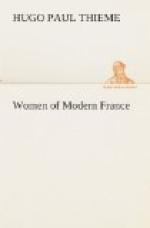The wholesome results of French women’s activity are reflected especially in art and literature, and to a lesser degree in religion and morality, by the tone of elegance, politeness, finesse, clearness, precision, purity, and a general high standard which man followed if he was to succeed. In politics much severe blame and reproach have been heaped upon her—she is made responsible for breaking treaties, for activity in all intrigues, participating in and inciting to civil and foreign wars, encouraging and sanctioning assassinations and massacres, championing the Machiavelian policy and practising it at every opportunity.
It has been the aim of this history of French women to present the results rather than the actual happenings of their lives, and these have been gathered from the most authoritative and scholarly publications on the subject, to which the writer herewith wishes to give all credit.
Hugo Paul Thieme.
University of Michigan.
Chapter I
Woman in politics
French women of the sixteenth, seventeenth, and eighteenth centuries, when studied according to the distinctive phases of their influence, are best divided into three classes: those queens who, as wives, represented virtue, education, and family life; the mistresses, who were instigators of political intrigue, immorality, and vice; and the authoresses and other educated women, who constituted themselves the patronesses of art and literature.
This division is not absolute by any means; for we see that in the sixteenth century the regent-mother (for example, Louise of Savoy and Catherine de’ Medici), in extent of influence, fills the same position as does the mistress in the eighteenth century; though in the former period appears, in Diana of Poitiers, the first of a long line of ruling mistresses.
Queen-consorts, in the sixteenth as in the following centuries, exercised but little influence; they were, as a rule, gentle and obedient wives—even Catherine, domineering as she afterward showed herself to be, betraying no signs of that trait until she became regent.
The literary women and women of spirit and wit furthered all intellectual and social development; but it was the mistresses—those great women of political schemes and moral degeneracy—who were vested with the actual importance, and it must in justice to them be said that they not infrequently encouraged art, letters, and mental expansion.
Eight queens of France there were during the sixteenth century, and three of these may be accepted as types of purity, piety, and goodness: Claude, first wife of Francis I.; Elizabeth of France, wife of Charles IX.; and Louise de Vaudemont, wife of Henry III. These queens, held up to ridicule and scorn by the depraved followers of their husbands’ mistresses, were reverenced by the people; we find striking contrasts




